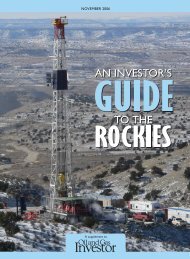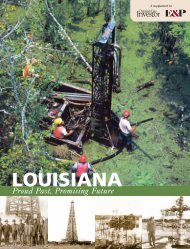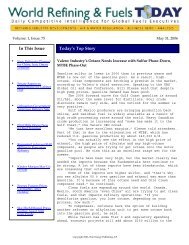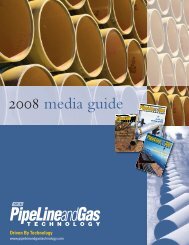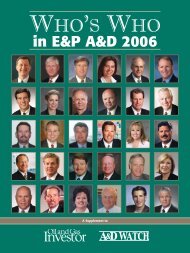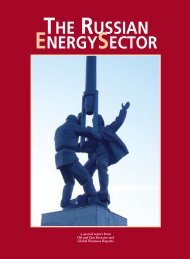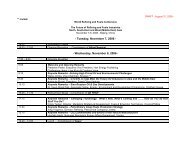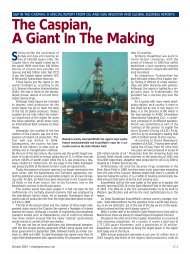ASTM: Gasoline Today and Tomorrow – An Executive Report
ASTM: Gasoline Today and Tomorrow – An Executive Report
ASTM: Gasoline Today and Tomorrow – An Executive Report
You also want an ePaper? Increase the reach of your titles
YUMPU automatically turns print PDFs into web optimized ePapers that Google loves.
Octane Week | <strong>ASTM</strong>: <strong>Gasoline</strong> <strong>Today</strong> <strong>and</strong> <strong>Tomorrow</strong> - <strong>An</strong> <strong>Executive</strong> <strong>Report</strong><br />
(from p3) Imran Hussami of Frontier Oil Corp. have<br />
developed silver methodologies based on modifications<br />
to D-130, most obviously, substituting a silver strip for<br />
the copper strip. Their separate processes have many<br />
similarities <strong>and</strong> critical differences. Both use 30 ml<br />
samples of gasoline that are heated to 50oC. Bainʼs test<br />
method specifies heating the sample for three hours<br />
while Hussamiʼs test method requires only two hours.<br />
At the end of the heating period in either method, the<br />
silver strip is removed <strong>and</strong> washed, <strong>and</strong> the color <strong>and</strong><br />
tarnish level is ranked.<br />
Both Bain <strong>and</strong> Hussami have developed methods<br />
having procedures for testing with <strong>and</strong> without a<br />
pressure vessel. Method A uses a pressure vessel <strong>and</strong><br />
method B involves the use of a vented test tube. Both<br />
have designed innovative devices for suspending a<br />
silver strip.<br />
“In the D-130 method, the copper strip was not<br />
suspended,” Bain said. “We had to study how to use the<br />
cable tie that was developed for suspending the silver<br />
strip, which is a little longer than the copper strip.”<br />
The underlying issue is one of incompatibility,<br />
she explained. “The metallurgy of certain fuel sensors<br />
is an issue when certain naturally occurring sulfur<br />
compounds in gasoline interact with silver. Automobile<br />
manufacturers are replacing silver sensors with a more<br />
robust metallurgy to remedy this problem,” she said.<br />
Bain reminded us that in 2000, Audi of America,<br />
Inc. voluntarily recalled 50,000 vehicles to replace<br />
the existing fuel sending units inside the fuel tank<br />
because they could cause the fuel gauge to read full<br />
while the fuel tank may not in fact be full or could be<br />
empty. Audi attributed interactions of certain reactive<br />
sulfur on contact points of any of the three fuel level<br />
sending units causing them to send an erroneous signal<br />
to the fuel gauge. Audi replaced the sending units with<br />
sturdier alloys.<br />
Suspension Devices Differ<br />
“<strong>Gasoline</strong> might not need the pressure<br />
vessel,” Bain told us. When using a pressure<br />
vessel (method A), the gasoline sample is placed<br />
in a clean <strong>and</strong> dry test tube. A prepared silver strip<br />
measuring 0.7 in. long, 0.5 inches wide <strong>and</strong> 0.1<br />
inches thick is placed inside the assembly (see<br />
fi gure right, Silver Strip Suspension Assembly,<br />
Method A), which is then placed in the test tube.<br />
The sample tube <strong>and</strong> suspension<br />
assembly are then placed in<br />
the pressure vessel. After<br />
three hours, plus or minus five<br />
minutes in the bath, the pressure<br />
vessel is to be withdrawn <strong>and</strong><br />
immersed for a few minutes<br />
in cool water. The technician<br />
is advised to open the pressure<br />
vessel carefully as contents may<br />
be under pressure.<br />
The strip is to be withdrawn<br />
from the suspension assembly<br />
with forceps <strong>and</strong> immersed in<br />
2,2,4-trimethylpentane, dried with ashless filter paper or<br />
cotton ball <strong>and</strong> inspected for tarnishing or corrosion.<br />
A silver corrosion interlaboratory study conducted<br />
by Marathon indicated that Method A <strong>and</strong> Method B yield<br />
equivalent results. Method B is advantageous because<br />
labs can use the same bath used in copper corrosion<br />
testing of finished gasoline. <strong>An</strong>other advantage is that<br />
labs do not need pressure cylinder vessels for testing<br />
silver corrosion.<br />
When testing without pressure (method B), the<br />
technician is to secure the silver strip as with a cable<br />
tie lanyard (see fi gure above, Silver Strip Suspension<br />
Assembly, Procedure B). The cable should hold the strip<br />
securely at the four corners but it should not contact any<br />
of the other surfaces. The assembly is to be placed in<br />
a test tube, <strong>and</strong> the test tube in a water bath for three<br />
hours. The silver strip is cleaned <strong>and</strong> compared in the<br />
same way as in the previous procedure.<br />
Thinner Strip Tested<br />
“Frontierʼs Hussami has also developed a modified<br />
D 130 test method, but it employs thinner, longer,<br />
reusable silver strips. This method suggests that strips be<br />
discarded when their original shape becomes deformed<br />
or the surface shows pitting, scratches or corrosion that<br />
cannot be removed by the specified polishing<br />
procedure. Polishing of unused, fresh strips is<br />
done with a 400-grit scouring-pad, while used<br />
strips are first polished with a piece of 150-grit<br />
roll, followed by the 400-grit pad.<br />
“At 1.5 inches long, 0.5 inch wide <strong>and</strong> 0.021<br />
inch thick, itʼs a fat-free silver strip,” Hussami<br />
quipped. This size has (continued on p5)<br />
4 February 2007



